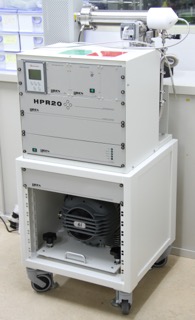Several brominated flame retardants (BFRs) have been found to have adverse effect on human health and the environment and classified as persistent organic pollutants (POPs). Mechanochemical destruction is a promising technology for the safe disposal of POPs because it can achieve their complete carbonization by solvent-free high energy ball milling at room temperature, thus preventing unintentional dioxins formation during the destruction process. With the financial support by the National High Technology Research and Development Program of China (2013AA06A305), we employed stoichiometric quantities of Bi2O3 or La2O3 as co-milling reagent (Bi/La-to-Br atomic ratio = 1) to destroy four BFRs (viz. decabromodiphenyl ether, decaBDE; hexabromocyclododecane, HBCDD; tetrabromobisphenol A, TBBPA; hexabromobenzene, HBB), which were selectively and completely converted into their corresponding oxybromides (i.e. BiOBr and LaOBr). These products possess very peculiar catalytic and optical properties, so can be used for some actual and many more potential industrial applications. In this way, bromine is beneficially reused in the final product, while POPs carbon skeleton is safely destroyed to amorphous carbon and CO2.
 During the mechanochemical destruction, carbonization of brominated pollutants to carbonaceous matter or their oxidation to CO2 must be ascertained: This is a key issue because it assures that potentially toxic (brominated) organic by-products are not generated. Amorphous and graphitic carbon is commonly found in the product of POPs mechanochemical destruction. On the other hand, oxidation to CO2 has been occasionally reported in literature. Some co-milling reagents induce its release in the milling jar headspace, while other ones (like various oxides) capture it to form carbonates. In the latter case, CO2 percentages are near 0.033%vol (i.e. the average amount in air), due to the thermodynamic equilibrium of carbonates with atmospheric CO2 (at room temperature). In this situation, it is not easy to discern whether the gas is really originated by the reaction, thus a precise and reliable quantification is necessary.
During the mechanochemical destruction, carbonization of brominated pollutants to carbonaceous matter or their oxidation to CO2 must be ascertained: This is a key issue because it assures that potentially toxic (brominated) organic by-products are not generated. Amorphous and graphitic carbon is commonly found in the product of POPs mechanochemical destruction. On the other hand, oxidation to CO2 has been occasionally reported in literature. Some co-milling reagents induce its release in the milling jar headspace, while other ones (like various oxides) capture it to form carbonates. In the latter case, CO2 percentages are near 0.033%vol (i.e. the average amount in air), due to the thermodynamic equilibrium of carbonates with atmospheric CO2 (at room temperature). In this situation, it is not easy to discern whether the gas is really originated by the reaction, thus a precise and reliable quantification is necessary.
In our experiments, carbonization process was confirmed by Raman spectra, where two bands, called “D-band” (1330–1380 cm-1) and “G-band” (1540–1580 cm-1), were attributed to the presence of amorphous and graphitic carbon, respectively. Independently from the co-milling reagent, D- and G-band of TBBPA and HBB were sharper than those of DecaBDE and HBCDD, implying a higher carbonization degree.
Carbon dioxide quantification of the jar headspaces by HPR-20 Real time Gas Analyser highlighted significant diversity when the reactions were conducted with Bi2O3 or La2O3 (Tab. 1). Bi2O3 was not carbonated by the CO2 generated during the destruction process. In particular, DecaBDE and HBCDD produced larger amounts of this gas, in comparison with TBBPA and HBB. On the contrary, low percentages of carbon dioxide were observed in all samples after ball milling with La2O3. Carbonates formation was corroborated by Fourier transform infrared analysis, confirming that the oxidation pathway also occurred with this reagent. In fact, the residual CO2 fractions (i.e. which did not react with La2O3) found with different brominated pollutants in the jar headspace showed a similar trend to those obtained with Bi2O3, suggesting that the oxidation reaction extent was analogous with both oxides and that it mainly depended on the molecular structure of the brominated POP.
Carbon dioxide formation can explain why the reactivity of Bi2O3, which required only 2-hour milling to achieve >90% conversion, is higher than that of La2O3, which needed at least 6 h milling to obtain almost complete conversion (Tab. 1). CO2 was not trapped into Bi2O3’s lattice and did not interfere with its reactivity. On the contrary, carbon dioxide was incorporated by La2O3 and LaOBr to form La2(CO3)3 and La(CO3)Br, respectively. The presence of CO2 in lanthanum oxide lattice hampered its activation by high energy ball milling, thus significantly reducing the reaction rate.
Tab. 1 – Atmosphere composition in the jar headspace after high energy ball milling.
|
Oxide |
|
BFR |
Milling time (h) |
Conversion (%vol) |
CO2 (%vol) |
N2 (%vol) |
O2 (%vol) |
Ar (%vol) |
|
Bi2O3 |
|
DecaBDE |
2 |
99.51 |
47.82 |
40.62 |
11.10 |
0.4584 |
|
|
HBCDD |
2 |
91.33 |
38.76 |
47.80 |
12.91 |
0.5282 |
|
|
|
TBBPA |
2 |
90.11 |
17.27 |
64.87 |
17.12 |
0.7397 |
|
|
|
HBB |
2 |
96.77 |
16.64 |
64.89 |
17.66 |
0.7192 |
|
|
La2O3 |
|
DecaBDE |
6 |
98.55 |
1.040 |
77.34 |
20.76 |
0.8605 |
|
|
HBCDD |
8 |
98.00 |
0.03440 |
78.31 |
20.79 |
0.8657 |
|
|
|
TBBPA |
8 |
98.51 |
0.02470 |
78.22 |
20.85 |
0.9053 |
|
|
|
HBB |
8 |
97.06 |
0.02370 |
77.80 |
21.28 |
0.9047 |
 Project summary by: Jun Huang, Associate Professor (with Tenure), School of Environment, Tsinghua University, No.1 Qinghuayuan, Haidian District, Beijing 100084 China
Project summary by: Jun Huang, Associate Professor (with Tenure), School of Environment, Tsinghua University, No.1 Qinghuayuan, Haidian District, Beijing 100084 China
Paper Reference: Giovanni Cagnetta, Han Liu, Kunlun Zhang, Jun Huang, Bin Wang, Shubo Deng, Yujue Wang & Gang Yu (2016) “Mechanochemical conversion of brominated POPs into useful oxybromides: a greener approach” Scientific Reports, 6, Article number: 28394. doi:10.1038/srep28394
Hiden Product: HPR-20 R&D
Project Summary Reference: AP-HPR-20-0002
View Full Paper: Mechanochemical conversion of brominated POPs into useful oxybromides a greener approach
To find out more about this product visit the HPR-20 R&D product page or if you would like to contact us directly please Send us a Message.

